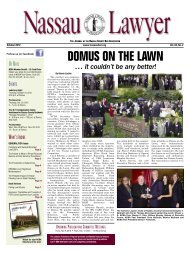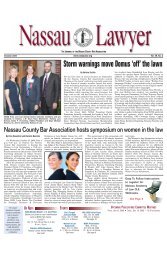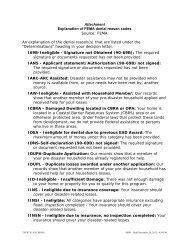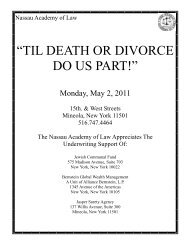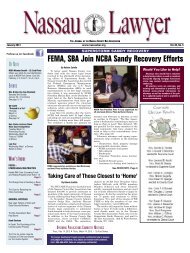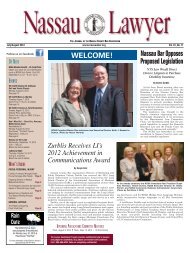302 B.R. 760 Page 2302 B.R. 760(Cite as: 302 B.R. 760)[7] Banks and Banking 10052k100 Most Cited CasesComplaint's extensive recitation <strong>of</strong> circumstances thatallegedly caused lender to suspect that borrower'sprincipals were fraudulently overstating its sales,including borrower's failure to comply with reportingrequirements set forth in loan agreement, was insufficient,standing alone, to satisfy "actual knowledge"standard for aiding and abetting claim under NewYork law.[8] Fraud 30184k30 Most Cited CasesAssertions that defendant who allegedly aided andabetted primary violator's breach <strong>of</strong> fiduciary dutyharbored well-founded but unconfirmed suspicions <strong>of</strong>primary violator's wrongdoing are insufficient to satisfy"actual knowledge" standard for aiding and abettingclaim under New York law, simply because,with benefit <strong>of</strong> hindsight, those suspicions turned outto be correct.[9] Banks and Banking 10052k100 Most Cited CasesAllegations in borrower's complaint, that lender thatprovided financing for borrower's business, uponlearning that debtor's principals had overstated borrower'ssales by fabricating false accounts receivable,had not gone public with this information, but hadrequired borrower to promptly repay its debt tolender with proceeds from sale <strong>of</strong> subordinated notes,thereby enabling borrower's principals to continuelooting millions <strong>of</strong> dollars from borrower, sufficientlyalleged lender's knowledge <strong>of</strong> this looting, as requiredunder New York law to state claim for aidingand abetting alleged looting; lender's knowledge thatborrower, a private company, was inflating its revenuesby reporting sales to defunct companies or companiesin wholly unrelated fields supported inference<strong>of</strong> lender's actual knowledge <strong>of</strong> this looting, especiallyin light <strong>of</strong> other allegations in complaint, suchas those regarding lender's investigation <strong>of</strong> borrower'spayments to its principals.[10] Fraud 30184k30 Most Cited CasesUnder New York law, "knowing participation" element<strong>of</strong> aiding and abetting claim requires more thandefendant's knowledge <strong>of</strong> primary violation; to stateclaim, plaintiff must allege some form <strong>of</strong> participationby alleged aider and abetter in primary wrongdoing.[11] Fraud 30184k30 Most Cited CasesUnder New York law, defendant may be held liablefor participating in another's breach <strong>of</strong> fiduciary dutyif defendant provided substantial assistance to primarywrongdoer.[12] Fraud 30184k30 Most Cited CasesUnder New York law, "substantial assistance" <strong>of</strong>fiduciary breach may be found, <strong>of</strong> kind sufficient tohold defendant liable for aiding and abetting thatbreach, where defendant affirmatively assists, helpsconceal or, by virtue <strong>of</strong> failing to act when requiredto do so, enables breach <strong>of</strong> fiduciary duty to proceed.[13] Fraud 30184k30 Most Cited CasesInaction by alleged aider and abetter in failing to investigateor to alert third parties <strong>of</strong> another's breach<strong>of</strong> fiduciary duty will not constitute "substantial assistance,"<strong>of</strong> kind sufficient under New York law toimpose aiding and abetting liability, unless allegedaider and abettor owes some fiduciary duty directlyto plaintiff; existence <strong>of</strong> primary violator's duty,without more, will not suffice.[14] Fraud 30184k30 Most Cited CasesUnder New York law, defendant may be liable asaider and abetter for inducing or encouraging fiduciaryto breach his duties to another, even though defendantdoes not directly assist in commission <strong>of</strong> underlyingwrong. Restatement (Second) <strong>of</strong> Torts §876.[15] Banks and Banking 10052k100 Most Cited CasesWhile allegations in borrower's complaint were sufficientto support inference <strong>of</strong> lender's actual knowledge<strong>of</strong> alleged fiduciary breaches by borrower'sprincipals, in fraudulently overstating borrower'ssales in order to secure financing while they continuedto loot borrower <strong>of</strong> its assets, allegations in complaint,that lender had not gone public with this information,but had required borrower to promptlyrepay its debt to lender with proceeds from sale <strong>of</strong>© 2009 Thomson Reuters. No Claim to Orig. US Gov. Works.
302 B.R. 760 Page 3302 B.R. 760(Cite as: 302 B.R. 760)subordinated notes, failed to sufficiently identify anyaffirmative act <strong>of</strong> participation by lender in principals'fraud, as required to support claim againstlender on aiding and abetting theory; allegation thatlender had allowed sale <strong>of</strong> notes to proceed by notexercising its contractual right to block borrowerfrom further borrowing alleged act that was in nature<strong>of</strong> one <strong>of</strong> omission rather than <strong>of</strong> commission, anddid not suffice.[16] Banks and Banking 10052k100 Most Cited CasesUnder New York law, bank's contractually bargained-forright to prevent borrower from engagingin any further borrowing by selling its subordinatednotes did not confer on bank any affirmative duty toprotect noteholders from actions <strong>of</strong> borrower's management,in engaging in such borrowing to obtainfunds to repay bank loan at time when bank allegedlyknew <strong>of</strong> massive fraud by debtor's management inoverstating its sales.[17] Fraudulent Conveyances 159(1)186k159(1) Most Cited Cases[17] Fraudulent Conveyances 162.1186k162.1 Most Cited CasesLender's acceptance <strong>of</strong> funds from borrower, in dollar-for-dollarrepayment <strong>of</strong> valid, preexisting loan,did not give rise to constructive fraudulent transferclaim under New York law, though lender allegedlyknew that borrower's management had raised fundsfrom sale <strong>of</strong> subordinated notes that operated as fraudon noteholders; lender's knowledge <strong>of</strong> fraudulent acts<strong>of</strong> borrower's management in connection with sale <strong>of</strong>notes did not affect its "good faith," for purpose <strong>of</strong>constructive fraudulent transfer claim, absent anyallegation <strong>of</strong> lender's participation in this fraud.N.Y.McKinney's Debtor and Creditor <strong>Law</strong> § 272.[18] Fraudulent Conveyances 77186k77 Most Cited Cases[18] Fraudulent Conveyances 86186k86 Most Cited CasesThere are three elements to "fair consideration,"within meaning <strong>of</strong> New York constructive fraudulentconveyance law: (1) recipient <strong>of</strong> alleged fraudulenttransfer must either convey property or discharge anantecedent debt in exchange; (2) exchange must befor a fair equivalent; and (3) exchange must be ingood faith. N.Y.McKinney's Debtor and Creditor<strong>Law</strong> § 272.[19] Fraudulent Conveyances 159(2)186k159(2) Most Cited Cases"Good faith" is not lacking, within meaning <strong>of</strong> NewYork constructive fraudulent conveyance law, simplybecause transferee knows <strong>of</strong> transferor's unfavorablefinancial condition at time <strong>of</strong> transfer.N.Y.McKinney's Debtor and Creditor <strong>Law</strong> § 272.[20] Fraudulent Conveyances 114186k114 Most Cited CasesMere fact that payment is preferential, in sense that itis made by insolvent debtor to satisfy debt to onecreditor at the expense <strong>of</strong> others, does not make itconstructively fraudulent conveyance under NewYork law; correction <strong>of</strong> such preferential treatment isnot aim <strong>of</strong> fraudulent conveyance law.N.Y.McKinney's Debtor and Creditor <strong>Law</strong> § 272.[21] Fraudulent Conveyances 159(1)186k159(1) Most Cited CasesLender's acceptance <strong>of</strong> funds from borrower, in dollar-for-dollarrepayment <strong>of</strong> valid, preexisting loan,did not give rise to actual fraudulent transfer claimunder New York law, though lender allegedly knewthat borrower's management had raised funds fromsale <strong>of</strong> subordinated notes that operated as fraud onnoteholders; alleged fraud concerned manner inwhich debt to noteholders arose, and not the subsequentconveyance <strong>of</strong> those funds to lender, whichwas legitimate creditor <strong>of</strong> borrower. N.Y.McKinney'sDebtor and Creditor <strong>Law</strong> § 276.[22] Fraudulent Conveyances 9186k9 Most Cited CasesUnder New York law, if there is actual intent to hinder,delay, or defraud creditors by means <strong>of</strong> conveyance,then conveyance can be set aside even if debtorremains otherwise solvent, and even if fair considerationis given in exchange for transfer.N.Y.McKinney's Debtor and Creditor <strong>Law</strong> § 276.[23] Bankruptcy 272451k2724 Most Cited CasesCause <strong>of</strong> action to avoid transfer as actually fraudulentas to creditors must be plead with particularity asrequired by Federal Rule <strong>of</strong> Civil Procedure.© 2009 Thomson Reuters. No Claim to Orig. US Gov. Works.
- Page 1 and 2: Nassau Academy of LawCLE Live Class
- Page 3 and 4: McKinney's Debtor and Creditor Law
- Page 5 and 6: McKinney's Debtor and Creditor Law
- Page 7 and 8: McKinney's Debtor and Creditor Law
- Page 9 and 10: McKinney's Debtor and Creditor Law
- Page 11 and 12: McKinney's Debtor and Creditor Law
- Page 13 and 14: McKinney's Debtor and Creditor Law
- Page 15 and 16: McKinney's Debtor and Creditor Law
- Page 17 and 18: McKinney's Debtor and Creditor Law
- Page 19 and 20: BAKER & HOSTETLER LLP45 Rockefeller
- Page 21 and 22: usiness of defendant Bernard L. Mad
- Page 23 and 24: BACKGROUND, THE TRUSTEE, AND STANDI
- Page 25 and 26: Madoff who received fraudulent tran
- Page 27 and 28: ased on fictitious profits and for
- Page 29 and 30: 28. BLMIS funds were also used to p
- Page 31 and 32: Madoff, and her niece, Shana Madoff
- Page 33 and 34: 42. Ruth Madoff was never an employ
- Page 35 and 36: FIRST CAUSE OF ACTIONTURNOVER AND A
- Page 37 and 38: 66. At the time of each of the Two-
- Page 39 and 40: Transfers; (b) directing that the S
- Page 41 and 42: EIGHTH CAUSE OF ACTIONUNDISCOVERED
- Page 43 and 44: TENTH CAUSE OF ACTIONDISALLOWANCE O
- Page 45 and 46: 111. Mrs. Madoff benefited from the
- Page 47 and 48: WHEREFORE, the Trustee respectfully
- Page 49 and 50: 2(c)(3): (a) preserving the Subsequ
- Page 51: 302 B.R. 760 Page 1302 B.R. 760(Cit
- Page 55 and 56: 302 B.R. 760 Page 5302 B.R. 760(Cit
- Page 57 and 58: 302 B.R. 760 Page 7302 B.R. 760(Cit
- Page 59 and 60: 302 B.R. 760 Page 9302 B.R. 760(Cit
- Page 61 and 62: 302 B.R. 760 Page 11302 B.R. 760(Ci
- Page 63 and 64: 302 B.R. 760 Page 13302 B.R. 760(Ci
- Page 65 and 66: 302 B.R. 760 Page 15302 B.R. 760(Ci
- Page 67 and 68: 302 B.R. 760 Page 17302 B.R. 760(Ci
- Page 69 and 70: 302 B.R. 760 Page 19302 B.R. 760(Ci
- Page 71 and 72: 394 B.R. 721 Page 1394 B.R. 721, 50
- Page 73 and 74: 394 B.R. 721 Page 3394 B.R. 721, 50
- Page 75 and 76: 394 B.R. 721 Page 5394 B.R. 721, 50
- Page 77 and 78: 394 B.R. 721 Page 7394 B.R. 721, 50
- Page 79 and 80: 394 B.R. 721 Page 9394 B.R. 721, 50
- Page 81 and 82: 394 B.R. 721 Page 11394 B.R. 721, 5
- Page 83 and 84: 394 B.R. 721 Page 13394 B.R. 721, 5
- Page 85 and 86: 394 B.R. 721 Page 15394 B.R. 721, 5
- Page 87 and 88: 394 B.R. 721 Page 17394 B.R. 721, 5
- Page 89 and 90: 394 B.R. 721 Page 19394 B.R. 721, 5
- Page 91 and 92: 394 B.R. 721 Page 21394 B.R. 721, 5
- Page 93 and 94: 397 B.R. 642 Page 2397 B.R. 642(Cit
- Page 95 and 96: 397 B.R. 642 Page 4397 B.R. 642(Cit
- Page 97 and 98: 397 B.R. 642 Page 6397 B.R. 642(Cit
- Page 99 and 100: 397 B.R. 642 Page 8397 B.R. 642(Cit
- Page 101 and 102: 397 B.R. 642 Page 10397 B.R. 642(Ci
- Page 103 and 104:
397 B.R. 642 Page 12397 B.R. 642(Ci
- Page 105 and 106:
397 B.R. 642 Page 14397 B.R. 642(Ci
- Page 107 and 108:
443 F.3d 180 Page 2443 F.3d 180(Cit
- Page 109 and 110:
443 F.3d 180 Page 4443 F.3d 180(Cit
- Page 111 and 112:
443 F.3d 180 Page 6443 F.3d 180(Cit
- Page 113 and 114:
443 F.3d 180 Page 8443 F.3d 180(Cit
- Page 115 and 116:
443 F.3d 180 Page 10443 F.3d 180(Ci
- Page 117 and 118:
443 F.3d 180 Page 12443 F.3d 180(Ci
- Page 119 and 120:
Page 2257 A.D.2d 526, 684 N.Y.S.2d
- Page 121 and 122:
Page 4257 A.D.2d 526, 684 N.Y.S.2d
- Page 123 and 124:
Page 6257 A.D.2d 526, 684 N.Y.S.2d
- Page 125 and 126:
770 N.Y.S.2d 421 Page 22 A.D.3d 780
- Page 127 and 128:
Page 14 A.D.3d 495, 773 N.Y.S.2d 71
- Page 129:
Page 34 A.D.3d 495, 773 N.Y.S.2d 71
- Page 132 and 133:
780 N.Y.S.2d 409 Page 29 A.D.3d 553
- Page 134 and 135:
Page 134 A.D.3d 231, 824 N.Y.S.2d 3
- Page 136 and 137:
Page 334 A.D.3d 231, 824 N.Y.S.2d 3
- Page 138 and 139:
Page 2991 F.2d 31(Cite as: 991 F.2d
- Page 140 and 141:
Page 4991 F.2d 31(Cite as: 991 F.2d
- Page 142 and 143:
Page 6991 F.2d 31(Cite as: 991 F.2d
- Page 144 and 145:
FRAUDULENT TRANFERENCESRonald M. Te
- Page 146 and 147:
Nursing home case_ Transfer of pers
- Page 148 and 149:
Sections 548 and 544 work in concer
- Page 150 and 151:
U.S. Supreme CourtBFP v. Resolution
- Page 152 and 153:
example, from net 15 to COD; or cha
- Page 154 and 155:
Bankruptcy Code Section§ 548. Frau
- Page 156:
Ron Terenzi is a founding partner a



